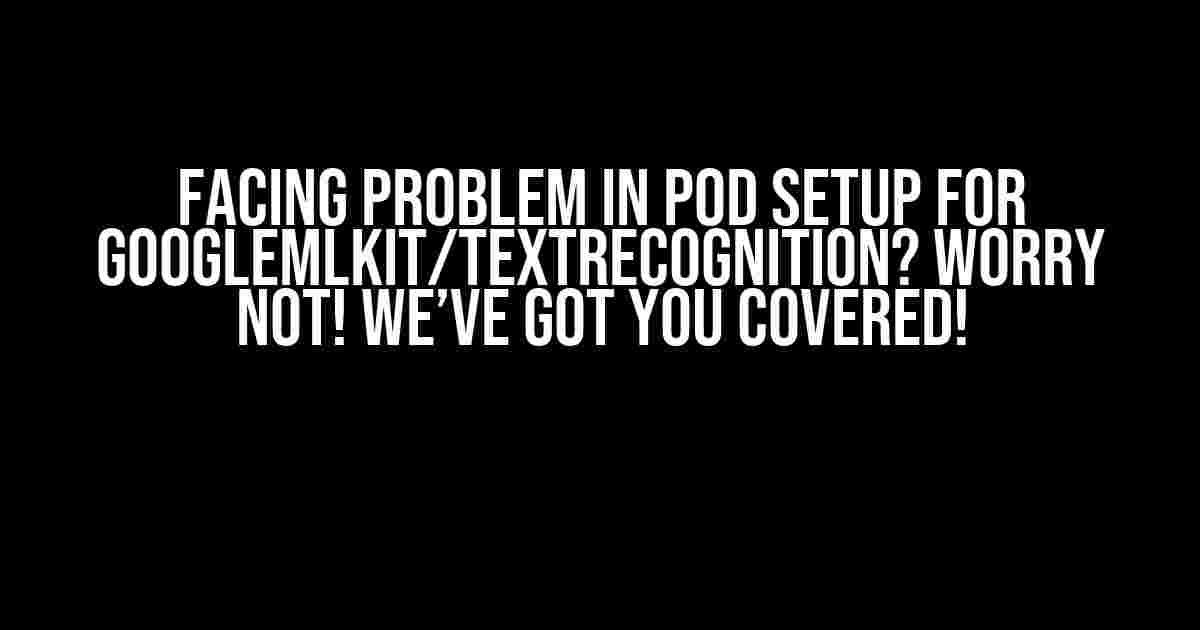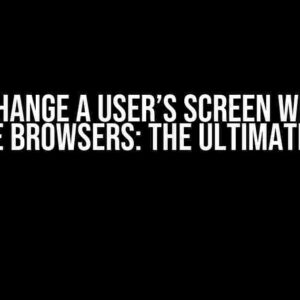Are you tired of spending hours trying to set up GoogleMLKit’s TextRecognition feature, only to be met with frustration and disappointment? Well, put those worries to rest because we’re about to take you on a step-by-step journey to resolve the pesky pod setup issues and get you up and running with TextRecognition in no time!
What is GoogleMLKit/TextRecognition?
Before we dive into the meat of the matter, let’s quickly revisit what GoogleMLKit/TextRecognition is all about. GoogleMLKit is a mobile SDK that provides a range of machine learning-powered features, one of which is TextRecognition – an Optical Character Recognition (OCR) technology that enables your app to extract text from images and videos.
Why Use TextRecognition?
TextRecognition is an incredibly powerful tool that can elevate your app’s functionality and user experience. Here are just a few reasons why you should consider integrating it into your project:
- Scan documents and extract text: With TextRecognition, your app can scan documents, receipts, or any other image-containing text, and extract the text in real-time.
- Enhance user experience: Imagine allowing users to capture an image of a business card, and instantly extracting the contact information – it’s a game-changer!
- Unleash new app possibilities: TextRecognition opens up a world of possibilities for apps in various industries, such as finance, healthcare, and education.
The Problem with Pod Setup
So, what’s the holdup? Why are you struggling to set up the pod for GoogleMLKit/TextRecognition? Common issues include:
- Pod installation errors: You might encounter errors during the pod installation process, such as version conflicts or dependency issues.
- Missing or incorrect frameworks: Without the correct frameworks, your project won’t compile, and you’ll be stuck.
- Incorrect or outdated documentation: Outdated or incorrect documentation can lead to confusion and frustration.
Resolving the Pod Setup Issues
Don’t worry; we’re about to walk you through a step-by-step process to resolve these issues and get your TextRecognition feature up and running. Follow along closely!
Step 1: Install GoogleMLKit Pod
Open your terminal and navigate to your project directory. Run the following command to install the GoogleMLKit pod:
pod initThis will create a new Podfile in your project directory. Open the Podfile and add the following lines:
target 'YourApp' do
use_frameworks!
pod 'GoogleMLKit/TextRecognition'
end
Replace ‘YourApp’ with your actual app name. Save the changes and run the following command:
pod installStep 2: Add Required Frameworks
In your Xcode project, navigate to the General tab and add the following frameworks:
| Framework | Version |
|---|---|
| GoogleMLKit | ≥ 1.3.0 |
| MLKitTextRecognition | ≥ 1.3.0 |
| CoreImage | ≥ 1.0 |
| CoreMedia | ≥ 1.0 |
| ALError | ≥ 1.0 |
Make sure to add these frameworks to your target’s Embedded Binaries section as well.
Step 3: Import GoogleMLKit and Set Up TextRecognition
In your Swift file, import GoogleMLKit and set up TextRecognition:
import UIKit
import GoogleMLKit
class TextRecognitionViewController: UIViewController {
let textRecognizer = TextRecognizer.textRecognizer()
override func viewDidLoad() {
super.viewDidLoad()
// Set up your image or video capture logic here
}
func recognizeText(from image: UIImage) {
let visionImage = VisionImage(image: image)
textRecognizer.process(visionImage) { result, error in
if let error = error {
print("Error: \(error.localizedDescription)")
return
}
guard let result = result else { return }
for block in result.blocks {
for line in block.lines {
for element in line.elements {
print("Extracted text: \(element.text)")
}
}
}
}
}
}
Troubleshooting Common Issues
Still facing issues? Don’t worry; we’ve got you covered! Here are some common problems and their solutions:
Issue 1: Pod Installation Errors
Solution:
- Check your Podfile for syntax errors or whitespace issues.
- Try running
pod deintegratefollowed bypod installto reinstall the pod. - Verify that you’re using the correct version of CocoaPods.
Issue 2: Missing or Incorrect Frameworks
Solution:
- Double-check that you’ve added all the required frameworks to your project.
- Verify that the frameworks are correctly linked to your target.
- Try cleaning the project by deleting the Derived Data folder and rebuilding.
Issue 3: Incorrect or Outdated Documentation
Solution:
- Check the official GoogleMLKit documentation for the latest guidance and updates.
- Verify that you’re using the correct version of GoogleMLKit and TextRecognition.
- Reach out to the GoogleMLKit community or Stack Overflow for assistance.
Conclusion
There you have it – a comprehensive guide to resolving pod setup issues for GoogleMLKit/TextRecognition. By following these steps and troubleshooting common problems, you should be able to get your TextRecognition feature up and running smoothly.
Remember, if you’re still facing issues, don’t hesitate to reach out to the developer community or seek additional resources. Good luck, and happy coding!
Word count: 1056
Frequently Asked Question
Stuck with setting up a pod for GoogleMLKit/TextRecognition? Don’t worry, we’ve got you covered!
Why am I getting a “pod not found” error while setting up GoogleMLKit/TextRecognition?
This error usually occurs when the pod is not correctly installed or configured. Make sure you have installed the GoogleMLKit/TextRecognition pod correctly by running `pod install` in your project directory. Also, verify that the `GoogleMLKit/TextRecognition` pod is included in your Podfile.
How do I import the GoogleMLKit/TextRecognition framework in my Swift project?
You can import the framework by adding `import GoogleMLKit/TextRecognition` at the top of your Swift file. Make sure you have added the `GoogleMLKit/TextRecognition` pod to your project and installed it correctly using `pod install`.
What is the minimum iOS version supported by GoogleMLKit/TextRecognition?
GoogleMLKit/TextRecognition supports iOS 10 and later versions. Make sure your project’s deployment target is set to iOS 10 or later to use the GoogleMLKit/TextRecognition framework.
Why is my text recognition model not working as expected with GoogleMLKit/TextRecognition?
There could be several reasons why your text recognition model is not working as expected. Check if you have correctly configured the TextRecognizer instance, and if the input image is correctly processed and passed to the recognizer. Also, verify that the model is correctly downloaded and initialized.
What are the system requirements for using GoogleMLKit/TextRecognition?
GoogleMLKit/TextRecognition requires a device with a minimum of iOS 10, 2GB of RAM, and a 64-bit architecture. Additionally, it requires a camera or an image to perform text recognition.


